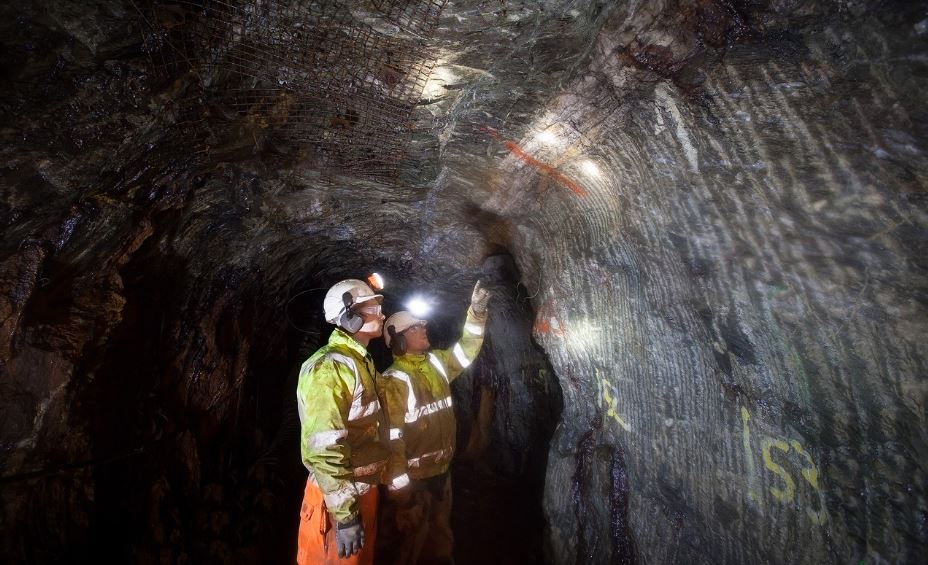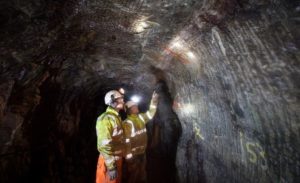Irish mine may prove challenging for Dalradian

Examining the high-grade gold veins at the Curraghinalt deposit in Northern Ireland. Source: Dalradian Resources Inc.
By Peter Kennedy

Dalradian Resources Inc. [DNA-TSX; DRLDF-OTC; DALR-AIM], the Canadian company that hopes to build a gold mine in Northern Ireland, said two leading independent proxy advisory firms have recommended that the company’s shareholders vote in favour of a previously announced takeover offer by Orion Mine Finance.
The transaction provides for the acquisition by Orion of the issues and outstanding shares of Dalradian by way of a statutory plan of arrangement, other than the Dalradian shares already owned by Orion, or its affiliates, and by certain members of Dalradian’s management team, Osisko Gold Royalties Ltd. [OR-TSX, NYSE], and Osisko CEO Sean Roosen.
Under the plan of arrangement, each Dalradian shareholder (other than the remaining shareholders) will receive $1.47 in cash for each share held. A special meeting of Dalradian shareholders to consider the transaction is scheduled for August 31, 2018 in Toronto.
On August 22, 2018, the shares were unchanged at $1.46 and trade in a range of $1.69 and 89 cents.
Dalradian is a mineral exploration and development company that is focused on advancing the high-grade Curraghinalt Gold Project in Northern Ireland, a region that has no history of large scale gold mining.
The Curraghinalt Project is estimated to host over 3 million ounces of measured and indicated gold resources. On top of that is another 3.1 million ounces of inferred material.
According to a technical report, a new mineral resource model is based on information from 731 core boreholes (178,130 metres and 678 underground channels (2,397 metres).
Gold mineralization at the Curraghinalt gold project is hosted in narrow, sub-parallel auriferous quartz-carbonate-sulphide veins.
The project covers 120,000 hectares consisting of six contiguous areas. It is accessible by a number of paved highways and is located 127 km from Belfast, the capital of Northern Ireland or 1.5 hours by car or truck. Dalradian owns 100% of the property, which lies within the Sperrin Mountains, an area of outstanding natural beauty.
A positive feasibility study released in December, 2016 said the Curraghinalt Project has the advantage of being located relatively close to the City of Belfast and approximately 60 km south of the City of Derry, both of which have port facilities. The proposed site is located in a natural hollow, surrounded by mature trees and near to the communities of Greencastle, Rouskey, Gortin, and Omagh.
“One of the project’s main competitive strengths is the high reserve grade, which would place it in the top 10% of gold mines world-wide,” the 2016 feasibility study concluded. “What is also very encouraging is that there are multiple opportunities to enhance the economics and extend the project life,” it said.
Test mining showed the viability of mechanized underground mining methods for this deposit.
The feasibility study envisaged average annual gold production of 130,000 ounces in the first 10 years with an average life-of-mine, all-in sustaining cash cost of $674 an ounce.
The study projected an estimated initial capital cost, including contingency of $192 million.
Other highlights included the creation of several hundred new jobs during the 18-24 month construction period. Direct employment is estimated to be at least 300 once the mine is in operation.
Dalradian has said its aim was to build Europe’s leading gold mine using best-in-class mining, processing and environmental standards, while facilitating economic development with the creation of at least 350 permanent jobs during operations.
Based on a gold price of $1,250/oz, the project is anticipated to generate average payments annually to the government, totalling approximately $21 million in the form of income tax, corporate tax, and natural insurance contributions.
According to the company’s most recent financial statements, cash and cash equivalents available to the company stood at $120.2 million as of June 30, 2018.
“Taking Curraghinalt to production continues to be the company’s primary goal and is being advanced in 2018 through drilling, engineering and geological studies, and environmental permitting activities,” the company said in a press release containing its 2018 second quarter results.
Meanwhile the company said it expects to release an updated feasibility study by the end of 2018.
The overall budget for 2018 is approximately $49 million for operational activities in Northern Ireland and Canada, including general and administrative costs. The two major items that represent approximately 50% of the operational budget are exploration and permitting, with planned expenditures roughly the same for both areas.
Mine design and engineering work to produce an updated feasibility study is the third-largest component at approximately 10% of the overall budget.
However, Northern Ireland media reports suggest that obtaining a mining permit may be an uphill struggle for Dalradian’s new owners.
According to a November, 2017 report by the Irish News, members of the Sinn Fein political party recently backed a motion opposing the future granting of permission for private mining of precious metals in Ireland.
The report said concerns have been raised by Dalradian’s plan to build a mine and associated plant that will use the hazardous chemical cyanide to remove the gold from ore mined locally.
In a speech to Sinn Fein party delegates, special government adviser Liam Lappin said residents in nearby communities are opposed to the use of cyanide.
He later added: “We need to take a stand against our nation’s wealth being signed off to private business interests whose sole objective is to make big profits.”
Aside from the concerns about cyanide, Orion may also be hampered by the fact that the region it plans to operate in has no history of large scale gold mining.
